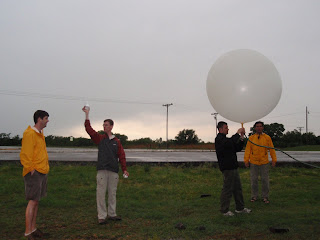One of the tools that we can employ to effectively launch balloons in windy conditions is a balloon bag. This is essentially a large, heavy duty tarp that has Velcro on the ends so that it can be wrapped into a long tube. You can then place the balloon inside the tube and inflate it. This not only protects the balloon, but also makes it much easier to handle as you maneuver it into position for a launch. In the photos below Kate, Dave and Matt M. (the NSSL2 team) demonstrate how this is done during operations on Friday, 5/15. We were conducting operations ahead of an approaching squall line, and conditions where quite windy, so the bag came in handy.
1) Inspect the bag for any debris such as small stones, twigs or anything else that may burst the balloon. Once inflated the balloons get quite large and can be easily popped.

2) Insert the balloon WELL into the bag. Otherwise it begins to squish out the end and becomes unwieldy, not to mention oddly shaped!

3) Inflate the balloon inside the bag. Safety goggles are a stylish accessory that will protect your eyes from flying latex in the event of a balloon burst.

4) Once the balloon is inflated, attach the radiosonde package that will record the temperature, humidity, wind and pressure data as the balloon ascends through the atmosphere.

5) With the sonde attached and the balloon still in the bag, move to your launch position. The balloon is easier to maneuver when it's inside the bag during windy conditions.

6) Once you're ready to launch have one or two people hold the bag (one of which should also be holding the sonde) while another person grabs the Velcro strip at the top of the bag and quickly rips it off. This allows the bag to open, releasing the balloon.

7) The balloon will rise out of the bag and it's up, up and away!

 Adam French (NCSU) and Chris Golubeski (NCAR) tie the radiosonde to their balloon.
Adam French (NCSU) and Chris Golubeski (NCAR) tie the radiosonde to their balloon.























